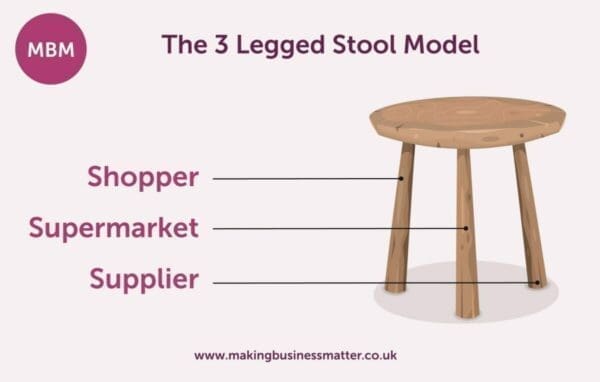7 Simple Ways To Understand The Category Management Process
We devised the funnel to help Category Managers focus, and ‘funnel down’, on what is important. The idea is that by following this category management process you will develop greater shopper understanding.
This, in turn, will help increase the landing rate of opportunities that reach the store. In essence, we believe Category Management is a ‘business as usual’ process, that is there to ‘identify’, ‘sell’ and ‘land’ more opportunities for your categories.
MBM’s Category Management Process Funnel
1. Agree on the Category Targets
Often, we find Category Managers fail to have agreed on a specific target for their category. Thus, they have no idea if it will be achieved. Without targets, you will have no idea where you are going, or indeed if you are already there. In short, the category is like a ship sailing on the ocean with no destination. Effective Category Management is, thus, impossible.
We suggest choosing one of the following:
To encourage…
- More people to buy from your category (Penetration).
- Existing customers to buy more often your category (Frequency).
- Customers to buy more from your category on each visit (Average Spend).
The choice is a simple one, and should only be one. We say only one as, for instance, often an increase in penetration may result in a net decrease in average spend. Moreover, it should be noted that if you focus on all three at once, your tactics will likely fail in your Category Management Process.

2. Understand Your Shopper
We have found that most Category Managers only focus on one-third of the overall ‘Shopper’ opportunity, the in-store customer. Missing two-thirds of the ‘customer’. Understanding only a small part of who buys the product. This, in part, brings us back to the old Customer vs. Consumer question. You should (hopefully) have noticed in this article that we use the term ‘consumer’ when we discuss the user of a product and a need being met. Likewise, we use the term ‘customer’ when we discuss the in-store purchaser. To reduce confusion, we at MBM like to use the following labels: ‘Shopper’, ‘Preparer’, and ‘Eater’.
We think it is important to consider that each stage of the process could include a different person. These different people will likely have different needs, motivations, and potential barriers. By using these terms we can better understand and target the ‘Whole Shopper’. Obviously, these could all be the same person. However, by breaking them down we maximise the opportunity to meet needs that may otherwise have been overlooked.
3. Know Your Supermarket
How aligned is your Category Management Process to the goals and needs of your Supermarket? We all know that you can’t fit a square peg in a round hole. For instance, do you know their strategies? Internal processes? In-store operations? Knowing your supermarket is essential. If you don’t you’ll be constantly chasing your buyer because they’ll be trying to navigate the guidelines, restrictions, and processes, whereas you could have when you presented. Awareness of these things will help you develop category tactics that fit.

4. Turn Analysis & Understanding into Opportunities
Many Category Managers get lost in the minefield of category data they have. Unfortunately, they often fail to correlate the best sources of data with the correct analytical tools and skills. As such, they rarely find deep insight and category opportunities. They become data regurgitators. Someone that just takes the data and presents it in a nicer way. This is because they fail to develop hypotheses before they start. By identifying hypotheses before you begin analysing the data, you will be more focused on category sales opportunities. We like to think of it as a targeted approach.
5. Sell £ Opportunities to Supermarket
Only 27% of opportunities ever make it in-store. Selling the opportunity can be the toughest part of the whole Category Management Process. A lot of hard work has gone into understanding and identifying the opportunity. Yet so many suppliers fall at this hurdle because they have not considered alternative ways to engage the Buyer. They simply create a slide deck. How would you feel sitting in front of a deck and being talked at for an hour 5 times a day?
6. Land Opportunities In-Store
Making sure that your recommendations to your Buyer don’t just look good on paper, but that they also will land well in-store. Often described as ‘the last 100 yards’ of the Category Management Process, store operations are often forgotten or ignored. As a Category Manager at a supplier, you have a responsibility to close that gap too. We can no longer abdicate responsibility for understanding stores to the Buyer.
Failing at this last hurdle will mean that all your hard work has ‘gone to pot’. The range/the promotion/the NPD will probably only last less than 12 weeks in-store. A little like the MD of a pizza company that once shared his story about his joy and dismay at getting into McDonald’s. A long story short – They had got into McDonald’s. All the hard work had paid off. One of McD’s requirements is that you work in a restaurant for a day. The MD obliged. The first order came in and was via the window (Drive through). Delighted. They cooked it, took it to the window. It would not fit through the window!
7. Evaluate & Improve Your Category Management Process
We quickly move from one project to the next, without knowing how to make the next project better. It is essential to understand how to measure your performance as a Category Manager and to continuously improve. Your target is to beat the industry average of 27% landing rate!
How will you ever be better, earn more, impress your boss, unless you know what went well and what didn’t go so well? The best salespeople in the world are told to evaluate, evaluate, evaluate. Hone your pitch. Write down your script. Seek feedback. Category Managers should be the same with their Category Management Process.
Find out about our training course that follows the funnel and our Category Management Process.



